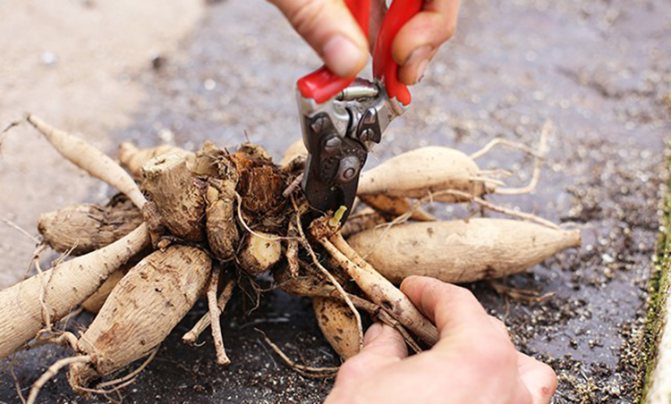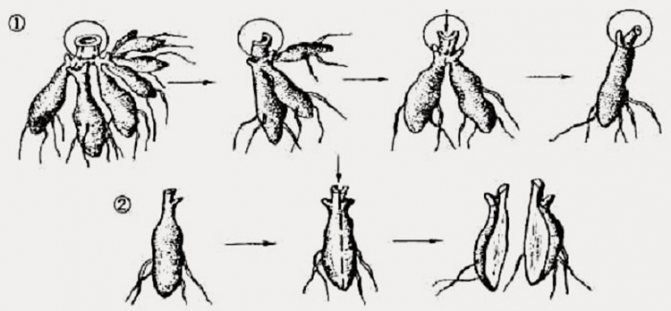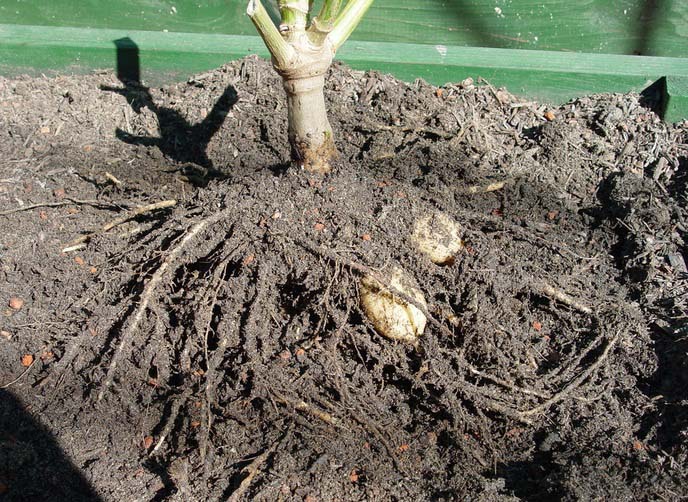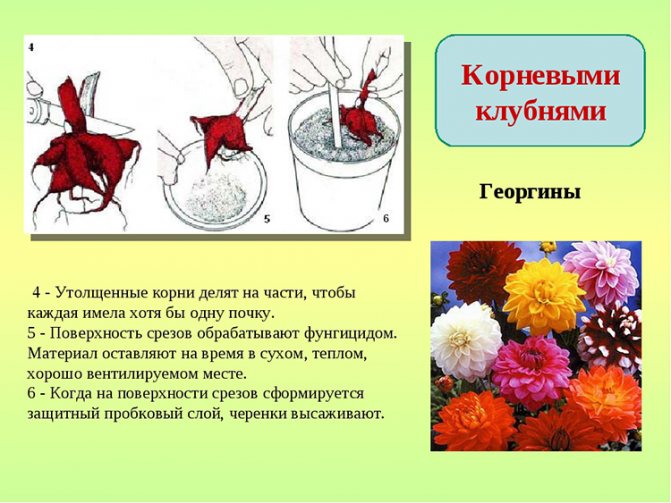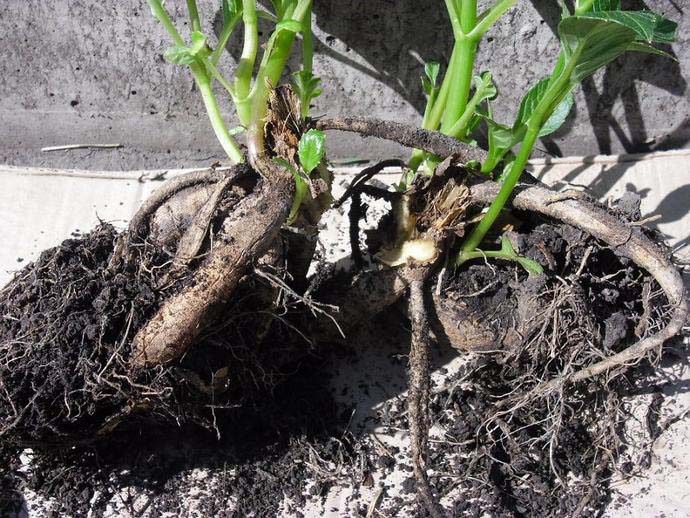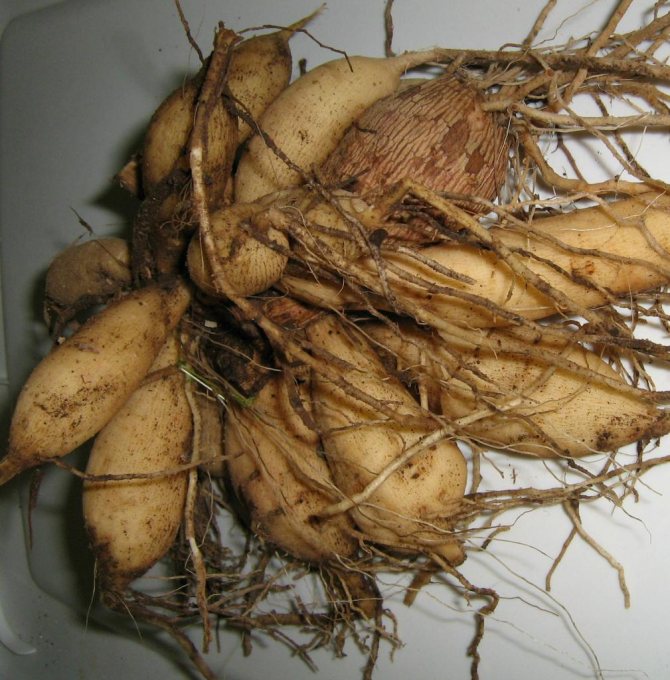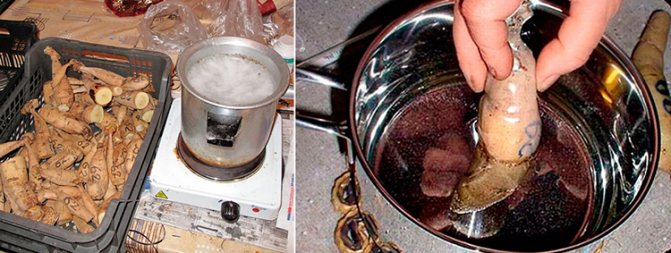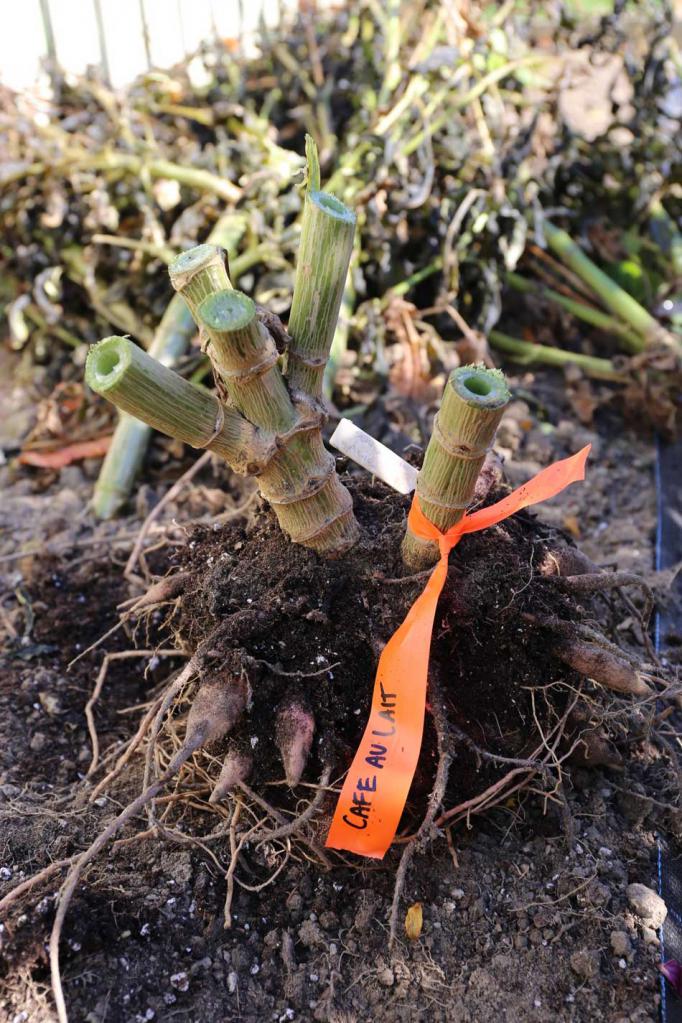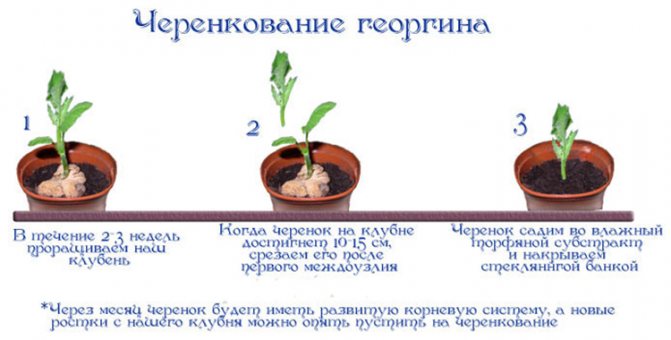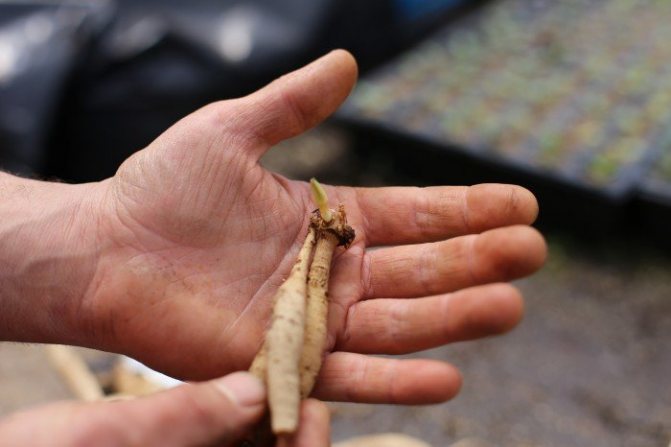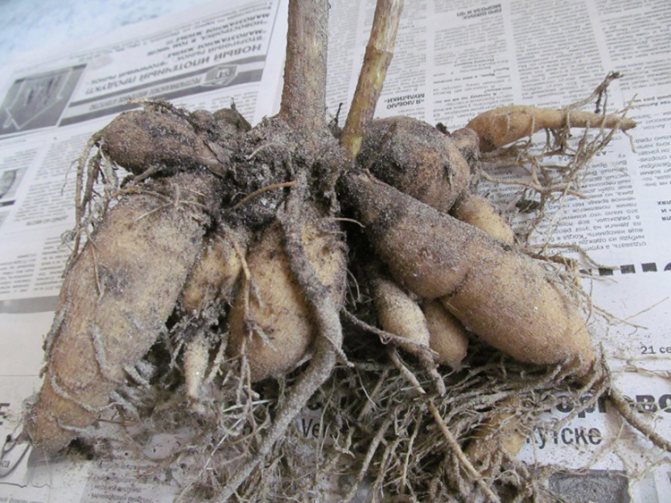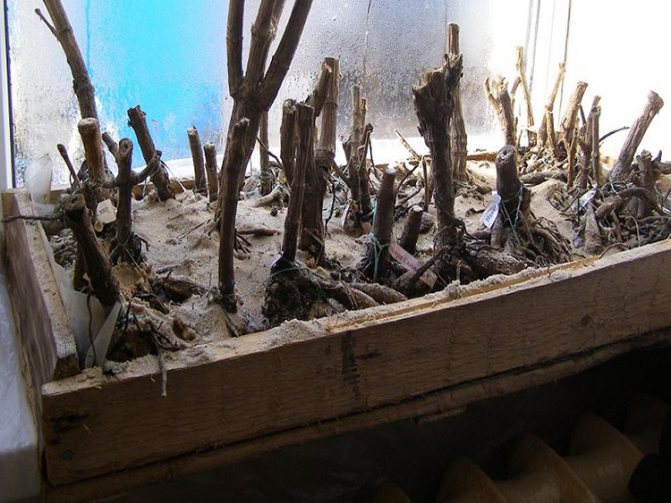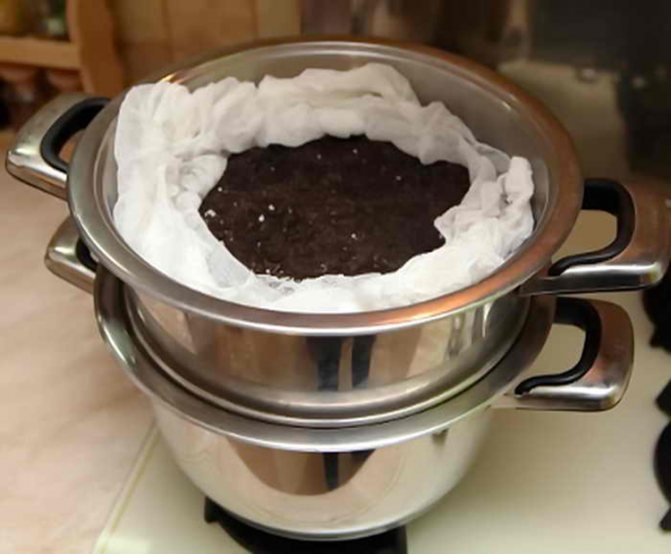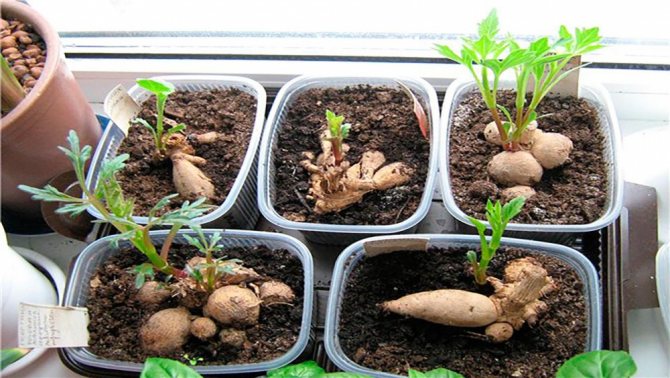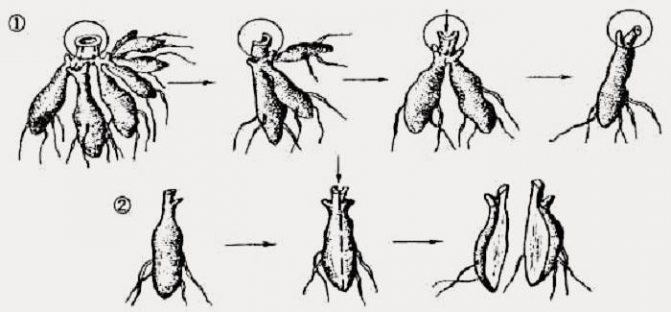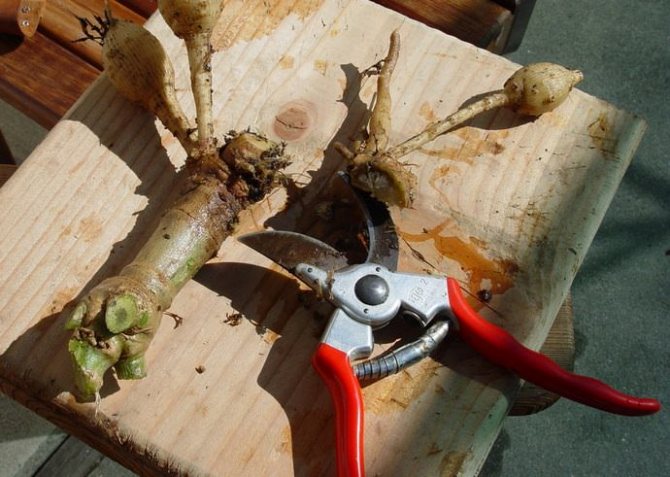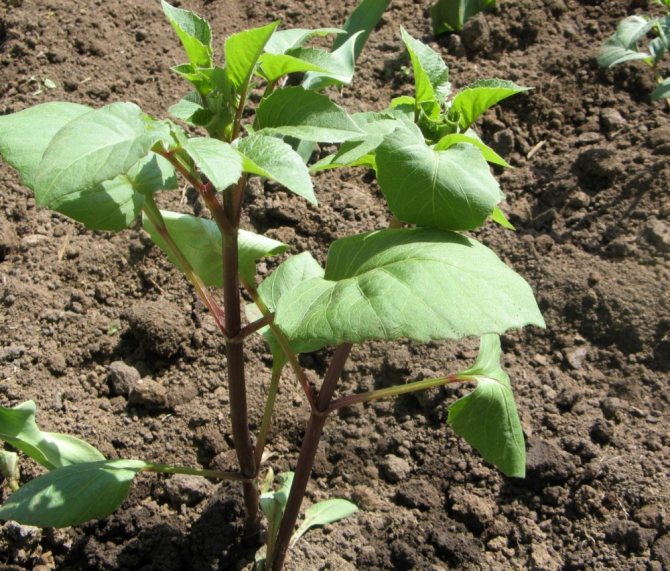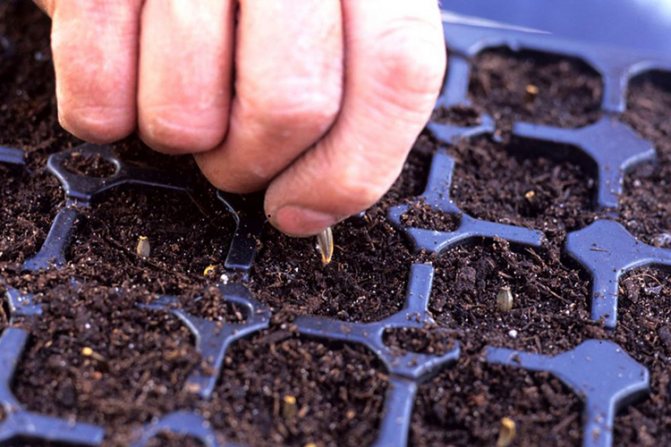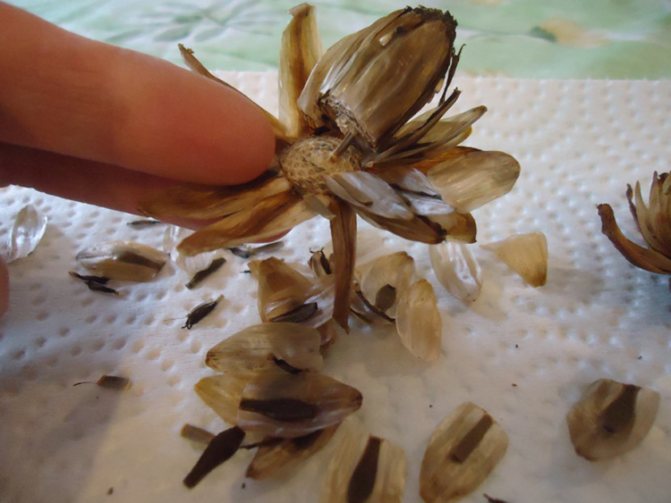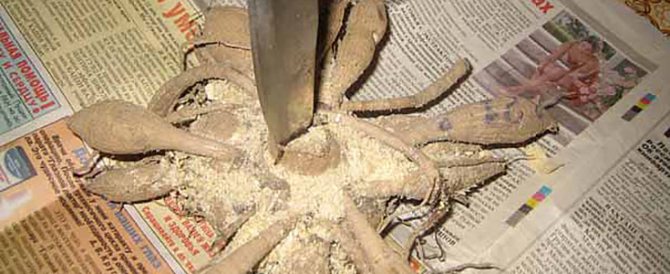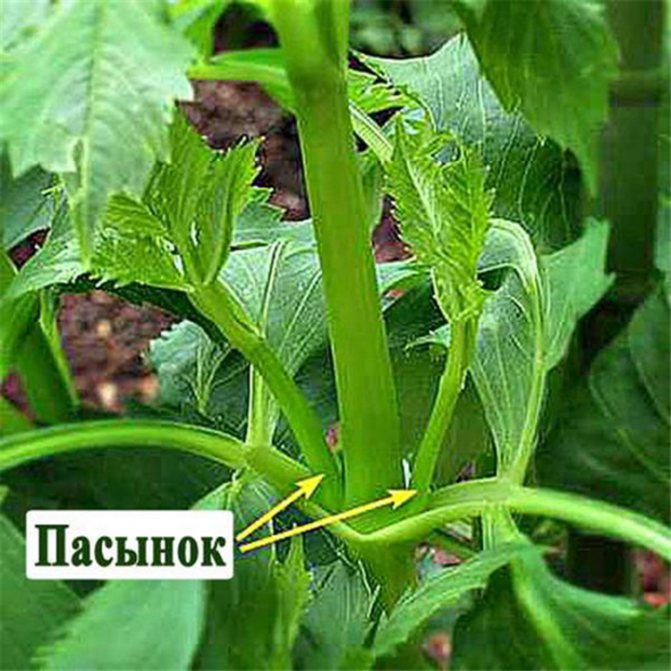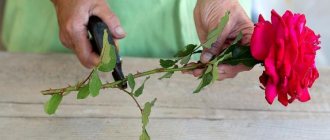Perennial dahlias are the favorites of flower growers. They will decorate and cover any, the most unassuming area. And due to the lush foliage and large flowers, they will create a bright floral accent in any corner of the garden. Breeders have created 15,000 varieties of dahlias, which are tuberous perennials. Every spring we take tubers out of the basements and carry out the procedure for dividing and germinating, otherwise the plants will be huge and spreading. And if we dream of getting a few more copies, then we cannot do without the knowledge of the reproduction of representatives of the Astrovs.

Before dividing, we dig out the planting material
If dahlia breeding is not planned, it is necessary to divide the bushes annually. If the plant has no more than two stems, then the flowers will be large in size. In the opposite case, the size of the flowers will be smaller, their brightness and saturation will disappear. Dividing dahlias in the fall leads to the fact that the bush becomes younger.
If the bush is purchased on the market, it still needs to be divided. You cannot plant a powerful rhizome. But in order to have something to share, the plant must be properly dug up and sent for storage before planting.
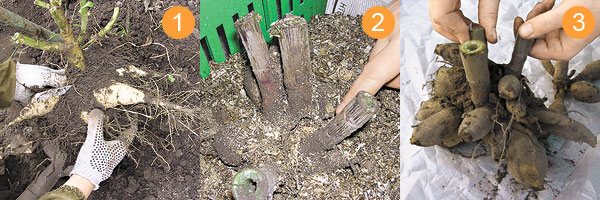

The bushes are dug up immediately after the onset of frost. Someone is in no hurry to dig up the plant. After all, it is quite possible that the weather will still be warm. The first frosts will affect only new blossoming flowers. The plant itself as a whole will not suffer from them. But do not forget that if frosts "burst out", the stem can be damaged, rot. We must not waste time and dig it up on time. After all, rot from the stem can go to the tuber. Therefore, any experienced gardener will say that timeliness is a determining factor in such events.
Dahlia is not a gladiolus. There are no increased requirements for weather conditions. Therefore, you can dig it even in rainy weather. If there are many plants, then all of them will not be planted. You don't have to dig up every single plant. You need to dig up the required amount, plus a small stock. What remains in the ground will rot and serve as a good fertilizer.
Important! Two weeks before digging, watering the plants is stopped. This is a prerequisite for good conservation.
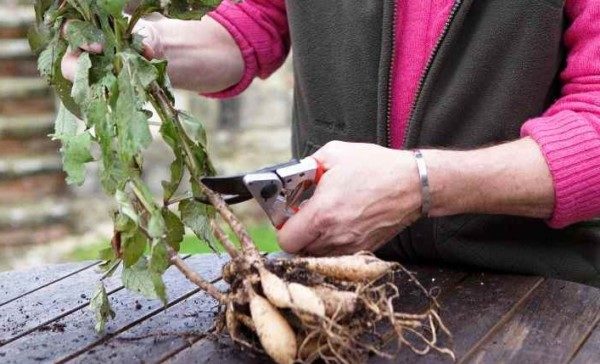

Dahlia cuttings according to the method of Marina Chernoivanova
The method of propagation of dahlias by cuttings of the grower Marina Chernoivanova is based on the described method, but somewhat improved. It allows you to get more shoots from one root tuber, and the grown plants are healthier and bloom early.
Features of the method:
- Root tubers need to be divided in the fall, before being sent for storage, while Marina Chernoivanova recommends removing the greyish stem as much as possible and cutting the trunk across so that it dries up and does not start to rot.
- You can plant from the beginning of December and by the end of the month you can get ready-to-plant sprouts. According to the observations of the grower during this period, they rot less and take root better.
- The cuttings should be separated from the tuber until the petals have opened, and the length of the plant is about 7 cm.
Vegetative propagation is a valuable way to preserve the plant's species characteristics, early flowering period and obtain high-quality and large flowers. Cutting dahlias is recommended for those who are seriously engaged in the cultivation of a blooming culture.For planting 2-3 bushes on the site, a simple division of the tuber is enough.
How to divide dahlia tubers
The choice is determined in favor of large, flowering shrubs. Before digging, the stems are cut to form stumps up to 30 cm high. This is a protection against breakage of the stems when digging. Indeed, this may damage the root neck. The earth must be shaken off, and what is left is washed off with water. Simultaneously with washing, small underdeveloped tubers are removed. But the main tubers that move away from the neck are left. They will have to be divided in the spring.
If the tuber is very long, it is shortened. It is enough to leave 15 cm. If there were several trunks on the bush, divide the rhizome.
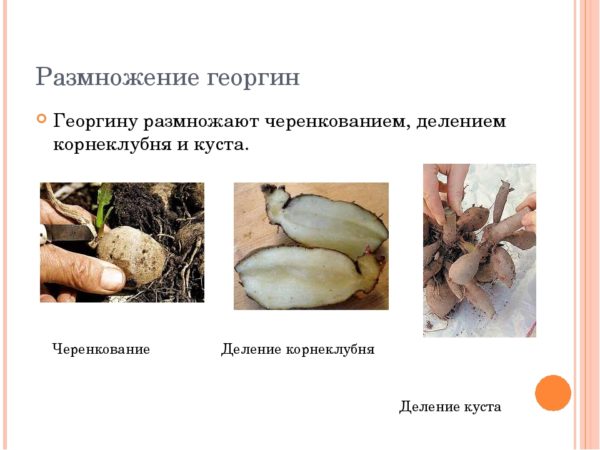

Tuber preparation
After that, the tubers are washed again with water. Another cut is carried out, leaving a stem 1-2 cm long. During storage in winter, the material may rot. The stem is the beginning of the process. He lays on the veranda for a couple of days. In case of severe frosts, it is removed to a room inaccessible to them.
Dahlia care
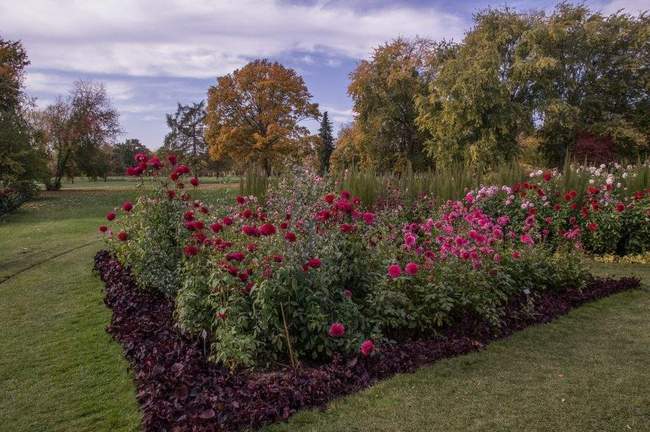

Feed flowers to get lush blooms.
In order for tall dahlias to have enough strength for both vegetative mass and abundant flowering, they need to be fed. For these purposes, infusion of mullein is often used.
It is prepared as follows: 1 bucket of manure is bred in 3 buckets of water and insisted for about a week under a lid. An unpleasant odor can be neutralized with wood ash by adding 1 kg to the infusion.
The finished product is diluted with water in a ratio of 1: 3 and top dressing is carried out immediately.
Such procedures should be carried out every 10-12 days. You can use not only mullein, but also bird droppings, the benefits of which can be read here.
When the first inflorescences form on the bushes, dahlias begin to feed with phosphorus-potassium fertilizers. And approximately, in the middle of August, fertilization is stopped. In addition to fertilizing, plants must be watered in a timely manner, especially during the formation of buds.
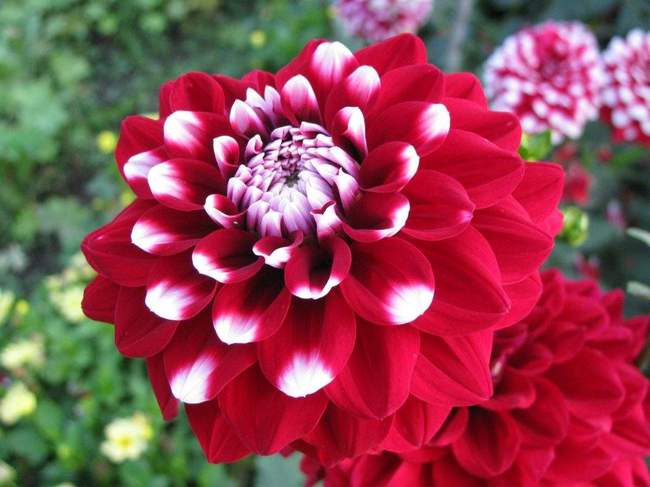

The soil under the dahlias is loosened, weeds are removed. But besides this, they also carry out pinching of plants, pinching of buds, and tying up the shoots.
To get large flowers, usually 1, 2 or 3 dahlia shoots are formed, and the rest are cut out. For the formation, of course, the strongest and largest shoots are left.
You can get large flowers by pinching the buds. Dahlia inflorescences, most often, consist of three buds. Pinch the middle one, growing on a short pedicel, and leave the other two.
Dividing tubers
Everything must be done carefully. To do this, the stem is loosened. Cutting of the mother element may be required.
How to properly divide a dahlia tuber?
Many people ask when to split dahlias, in spring or fall? In fact, you can do it in any of these periods.
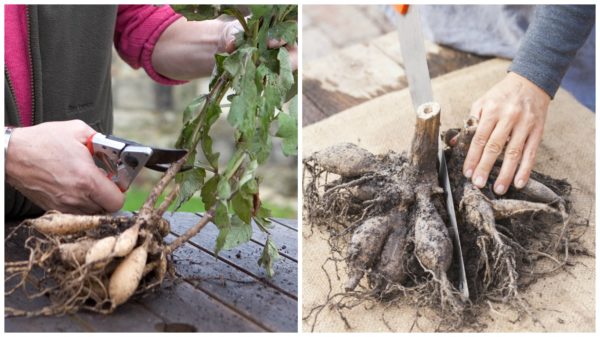

Autumn division
Anyone who does this in the fall should have a clear idea of how to divide the dahlia tubers in the fall. These manipulations should be carried out using a sharpened cutting tool. It is permissible to use a knife or scissors.
How to do division
- Using a sharp knife, split the remaining part of the stem into two parts. In this case, the growth bud should be located on both sides. Everything must be done as carefully as possible and do not allow the stem to separate from the rhizome. In principle, there will be no big trouble if this does happen.
- The rhizome is stretched to the sides. After that, the inoculum is examined. If there are many kidneys, then the procedure is repeated. In a similar way, one large root can be divided into several parts. A new plant will be formed from them.
- The ideal planting material is a whole tuber or a part of it with a bud. If there are two buds, then re-cutting is carried out on a cutting board.In this case, you must use a sharp knife. The given algorithm of actions is the answer to the question of how to divide dahlias in the fall.
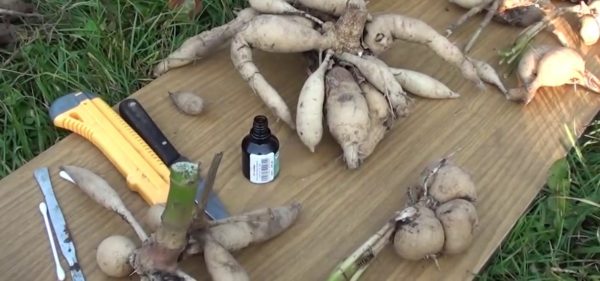

Spring division
There is no consensus among gardeners about the time of separation. Some believe that autumn is the best time for such an event. Others are of a different opinion. In winter, as a result of natural selection, the buds are well marked. Therefore, the separation is best done in the spring, they say. If this is done in the spring, then 3 weeks before planting, the material is taken from the storage location and inspected. If the buds are alive and have moved away from hibernation, the tubers are separated. The buds may not be visible as a result of the drying out of the tubers. They must be sprinkled with water, and left to germinate for a while. Then they are separated.
An experienced florist knows how to split a dahlia root for planting. The florist receives more planting material.
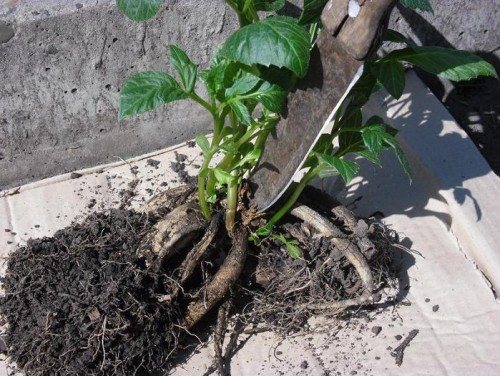

What is the grafting method
Dahlia propagation by cuttings is used when you need to get a maximum of new plants, for example, when planting a flower garden for cutting, rejuvenating old tubers, breeding a rare variety, or in case of the death of most of the planting material during wintering. The essence of the method is planting tubers in winter or early spring at home, followed by cutting off young shoots and rooting them. The method is not the easiest and rather lengthy, so it is not suitable for everyone. In addition, plants will need to create comfortable conditions and provide additional lighting.
Dahlia propagation by cuttings
Cuttings are an effective breeding method. For this, grown young plants are used. It is best to do this in a greenhouse, but you can also do it in a cold greenhouse. Its own root system is being formed. When favorable conditions are created, continuous development takes place. Rooted cuttings are planted shallowly. When placing seedlings in a pot, planting is carried out deeper. The lump falls below the soil surface by 7 cm.
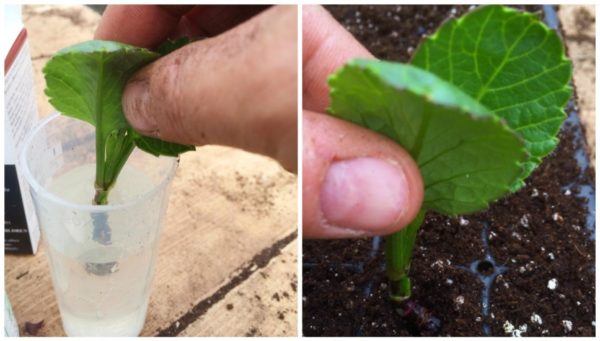

The use of unsuitable material is fraught with failure. It is impossible to cut too early. The early date for most varieties is late February, early March. At this time, he is transferred to a warm room. If there is no need for a large number of plants, it is allowed to do this in April.
It is imperative to divide the bush into parts. The shoot appears from below, and it is very problematic to get a cutting of the required quality from it. It is best to work with short cuttings.
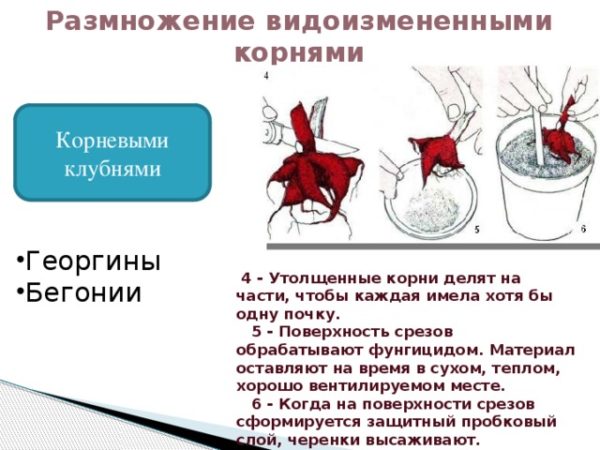

The main methods of breeding
Due to the reproduction of dahlias, you can get not only young plants, but also experiment, creating new specimens that will differ in size and color shades. There are 5 known ways of dividing a flower culture:
- tubers;
- using vaccination;
- seed method;
- cuttings;
- reproduction by "sports".
Every method has a right to exist, but not all of them are simple and easy to implement. In addition, the varietal qualities of the original specimens are not always preserved, but if there is a desire to experiment, then there are more than enough opportunities.
Seed reproduction
Florists know how to propagate dahlias to get new, interesting shapes.
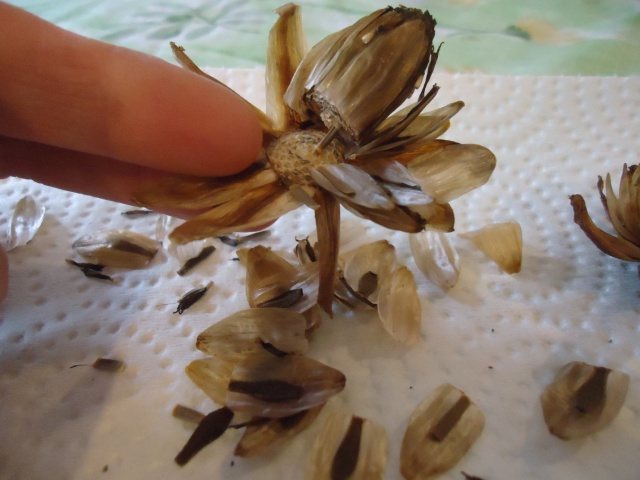

This opportunity is provided by growing from seeds. For this, wilted inflorescences are cut off in the autumn. They are hung up for ripening in a dry room. Ripe seeds are selected from the inflorescences, dried again and folded into paper bags until spring. In March, you can sow seedlings.
Advice! If the frost occurs too early, then the inflorescence can be cut off and placed in water until it fades. Then use the above technique.
Division by "sports"
The division of dahlias with "sports" is a relatively new and unusual technique.By "sports" is meant genetic mutations when a branch with a flower of a different shade appears on a plant. To obtain a new variety, it is carefully cut and divided by grafting, leaving it for adaptation and rooting until the next season, and after spring planting, the growth of a new specimen is observed.
Vaccination use
Not everyone knows how to propagate dahlias by grafting, since this is a troublesome process that requires a lot of time and effort. But this method makes it possible to bloom earlier and tubers grow to normal size by autumn. Usually, when dividing, tubers are always left, which are used for grafting.
The tuber is washed, dried and a deep hole is made in it. A stalk is sharpened, its lower part taken from an exotic (bright, unusual) specimen, and introduced into a tuber with a pre-prepared notch, wrapped and planted for subsequent growth.
But basically the division of dahlias in the spring is carried out by the two most popular methods - dividing the tubers and cutting. These are the most convenient and uncomplicated breeding methods, but some tricks exist here as well.
Methods for stimulating early flowering and plant formation are reflected in the video:
Reproduction of dahlia tubers
Tubers in March should migrate to a warm room. A sufficient amount of light is required. Here they are germinated. Before that, remove everything that has been damaged. For ten minutes, the planting material is dipped in a weak solution of potassium permanganate (0.2%). Then it is planted in boxes and sprinkled with sandy soil. The root collar is open, the ground is moist. Divide after 10 days. For this purpose, the root tuber is cut into pieces. Each contains at least one peephole. When planting, the incision remains free of backfill.
Conditions for growing dahlias
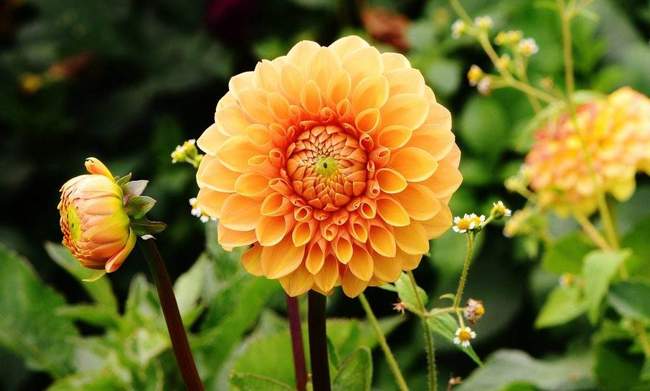

Dahlias cannot stand waterlogging
When planting dahlias, you need to consider their preferences. These plants love warmth, so well-lit areas are allocated for them. Dahlias grow well in fertile, loose soil with a neutral reaction. In addition, the soil must be moist.
Strong winds can break the tubular stems of dahlias, so areas where wind or drafts are constantly "walking" are not suitable for these flowers.
Stagnation of moisture in the soil should be avoided.
Separation times for garden dahlias
Separating dahlias, rejuvenating them and leaving the root tubers of the optimal size, is necessary at a time when they are outside the soil - before or after laying for storage. The choice between autumn and spring separation should be made depending on convenience, habits or capabilities, the peculiarities of the weather in the fall during excavation, and even the conditions in which the rhizomes are stored.
Each of the two splitting options has its own advantages and disadvantages:
Autumn dahlia division
It is considered the easiest and most productive way. In the fall, when the rhizomes are dug up, you still have to clean them, treat them with fungicides, inspect and remove damaged parts. Therefore, the already clean and ready-to-store delenki can only be divided so that in the spring they can immediately start preparing for planting.
The main advantages of this method are the lower risks of being hit by viruses and diseases, and the simplicity of the process itself. But the risks are also big:
- smaller cuttings tolerate wintering outside the soil worse;
- the risk of drying out or being affected by diseases is higher.
Spring dahlia division
It is carried out before the start of the awakening of the rhizomes, before the start of the gardening season. Overwintered dahlias are re-examined, discarded. In the spring, you can assess their real state, the kidneys by the end of March (and with proper storage, it is during these periods that the dormant period ends) stand out well, they are easy to detect and evaluate.
Read our detailed material: Preparation, germination and planting of dahlia tubers.
The percentage of planting material loss is less, and the size and quality of the divisions are easier to determine. Large dahlias are better stored, so many people prefer splitting before preparing for planting, and not after digging. True, the complexity of separation, the hardness and lethargy of the peel, the greater risk that an infection will spread to a large nest, are not always offset by the benefits.
Whichever option of separation is chosen, it should be remembered that careful work and thorough examinations, the absence of haste are the key to success in both cases.
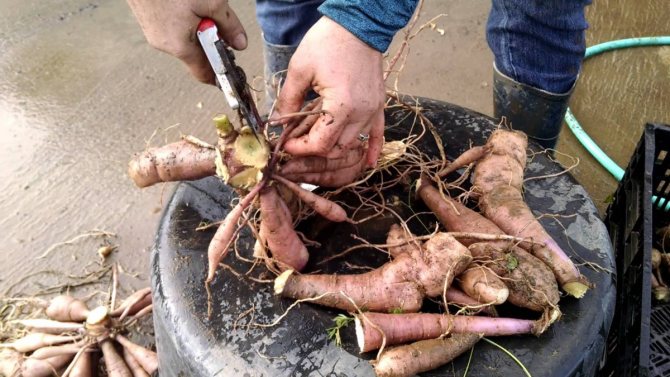

Autumn division of the dahlia rhizome. <>
Procedure execution
One of the methods that allows you to qualitatively propagate dahlias is to use tubers. This method is not applicable in all cases. A signal that the tubers are ready for reproduction is the presence of buds on the neck of the dahlia. After a certain time, they must transform into the so-called sprouts.
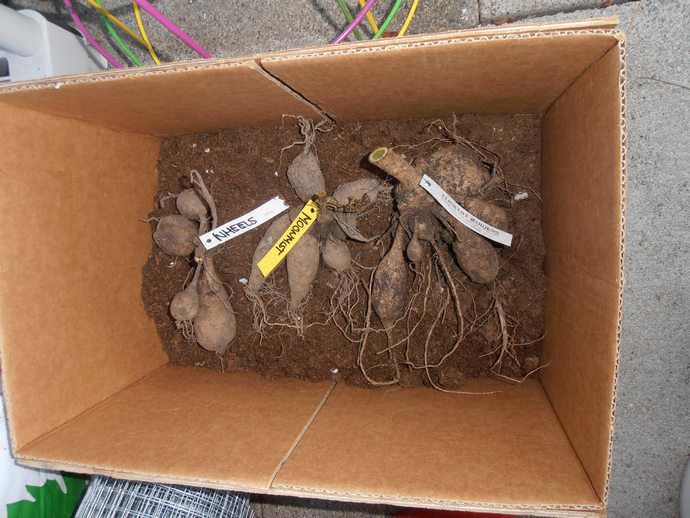

How to propagate the flower in question using the tuberous method in order to achieve a positive effect? Most professional florists focus on the timeliness of the procedure.
- Until the end of March, tubers are usually stored in special storage facilities, where special conditions have been created to prevent them from spoiling. In early April, they are moved to a room where it is warm enough to warm up.
- Tubers should be additionally dealt with only if their condition is unsatisfactory. It often happens that they become lethargic. This does not mean that such tubers are no longer suitable for reproduction. The situation can be saved. The tubers must be placed in cool water for 11-12 hours. Then they are taken out of the water and left for 10-15 minutes to dry.


- This is followed by the planting of the prepared material. This will require special boxes. They are filled with earth and sand. Tubers are placed there and covered with earth. The neck of a dahlia, which has a root character, should not be covered with earth. This part of the tuber must be open, otherwise the flower cannot be propagated by the method in question. To implement this stage as correctly as possible, you can see how the specialists do it.
- The boxes with the planted tubers are placed in the greenhouse. If this condition cannot be ensured, then you can use an alternative option - a greenhouse. Caring for planted tubers means ensuring the correct moisture level in the soil. The first watering is done immediately after planting, it should not be plentiful.
- In the early days, experts recommend that you carefully monitor that the soil is not very wet. This parameter should fluctuate within moderate limits. After 3 days, the moisture level is increased, since the tubers are already moving to a new stage of development.

